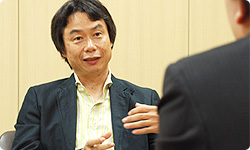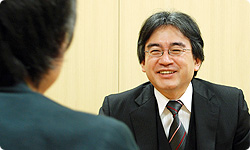4. Letting Everyone Know It Was A Good Mushroom
What were your initial considerations when you began working on Super Mario Bros. for the Famicom?
After Mario Bros., there were a fair few jumping-style games released by various companies and I felt that this kind of jumping game had been our idea.
Donkey Kong involved jumping, as did Mario Bros., so you felt that Nintendo were the real originators of this kind of game.
I did. I went as far as thinking that jumping is an original idea and that it should be patented! Anyway, I thought: “Right, I’m not going to let those other games top us!” (laughs) We had done tests where a large character jumped around with the blue sky in the background…
Video games at that time usually had a black background.
Video game designers back then wanted to keep that black background as it was less tiring for the players’ eyes to see. But I felt like the time had come when people were tiring of that and I thought it might be good to have a primary colour background that varies. So we utilised the technical capabilities of the Famicom to the full and decided to make Super Mario Bros. based on the concept of having a large character who would negotiate land, sea and air.
The game takes place on land, sea and air, with underground sections as well. Had you decided right from the start that it should be a large character that negotiated this terrain?
We had broadly decided on this approach. A large character that would run around on the ground...
…And swim in the sea.
In terms of the game’s structure, the swimming part is Balloon Fight 16. 16 The arcade version of the action game Balloon Fight was released in 1984 with a version released for the Famicom in Japan the following year.
You’re right. That’s exactly what it is.
With Balloon Fight previously launched, that system of controls had been tried and tested. For the sky, we had the image of Sun Wukong from Monkey jumping between clouds.
And what was behind the idea of having a large character?
We started off by doing tests to see how it would feel for the player to control a large character, double the size of Mario. As it felt really good, we continued to develop the idea. But then we discovered that it was more satisfying if Mario only increased in size part-way through the game, so we decided to make a small Mario as well.

By collecting a mushroom, Mario increases in size to become Super Mario. But why a mushroom?
Well, the mushroom… When you think about Alice in Wonderland, you think about mushrooms, right? (laughs)
(laughs)
Some time ago I was being interviewed and I spoke about Alice in Wonderland. But it seems there was some misunderstanding and it’s since been stated that I was influenced by Alice in Wonderland. That isn’t the case. It’s just that there has always somehow been a relationship between mushrooms and magical realms. That’s why I decided that Mario would need a mushroom to become Super Mario.
The mushrooms don’t just sit there, but actually move. What gave you that idea?
Well, in games you can either have objects following you that move at the same speed as you, objects that follow you but are a little slower than you, or objects following you that are a little faster than you. That speed makes all the difference in terms of how fun it is. We repeatedly did trials and saw the results, and I was adamant that something that you really want which is escaping you at a bit slower speed than you would be really fun.
You can experience the enjoyment of chasing something.
Right. There was one problem, however. When you play, you encounter a Goomba right at the start and it’s shaped like a mushroom.
It does look very similar.
So when you hit a box and something that looks like a Goomba pops out…
You run away.
Right, you run away. This gave us a real headache. We needed somehow to make sure the player understood that this was something really good. That’s why we made the mushroom approach you.
Yes, that’s right. If you play the game for the first time with no prior knowledge, you're going to run into the first Goomba and lose a turn.
Right, which is why you have to teach the player in a natural way that they need to avoid them by jumping over them.
Then when the player tries to jump and avoid them, there are going to be times when they get it wrong and end up stamping on the Goomba. By doing that, they learn in a natural way that by stamping on them, you can defeat them.
As long as you stamp on them, you have nothing to fear from Goombas.
But if you avoid the first Goomba and then jump and hit a block above you, a mushroom will spring out and you’ll get a shock. But then you’ll see that it’s going to the right so you’ll think: “I’m safe! Something strange appeared but I’m okay!” But of course when it goes against a pipe up ahead, the mushroom will come back! (laughs)

Right! (laughs)
At that point, even if you panic and try to jump out of the way, you’ll hit the block above you. Then just at the instant where you accept that you’re done for, Mario will suddenly shake and grow bigger! You might not really know what’s just happened, but at the very least, you’ll realise that you haven’t lost the turn.
But you’ll wonder why Mario suddenly got larger.
You’ll try jumping and see that you can jump to higher places and smash through the ceiling, so it'll be clear that you’ve become more powerful.
It’s at that moment that you first realise that the mushroom is a good item.
That’s the reason why it’s designed so that whatever you do, you’ll get the mushroom .
Of course it's because we wanted the player to realise that this item was different from a Goomba.
When I first realised that this had all been designed with that purpose in mind, I was really taken aback. When you tell people who weren’t aware of it that the start of Super Mario Bros. was designed with this intention, it’s rare that they won’t be impressed.
Is that right?
It’s not as if it was me who came up with it, but I've gone around bragging about it to plenty of people! (laughs)
(laughs) It wasn’t an idea that was in the original design plan for the game. It’s something we thought about as we were making the game. But happily, it turned out for the best…
So it’s not the case that you can foresee everything before you start. Rather, as you develop the game, you gradually work on things by saying: "Perhaps it would be better like that… Maybe it would work better like this…”
I always endeavour to develop games through a process of trial and error, sometimes taking an objective point of view and sometimes looking at things from the player's perspective.
